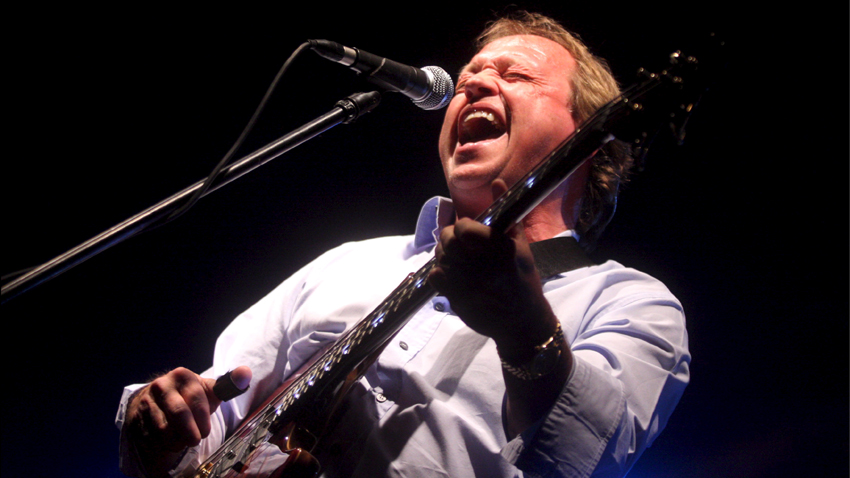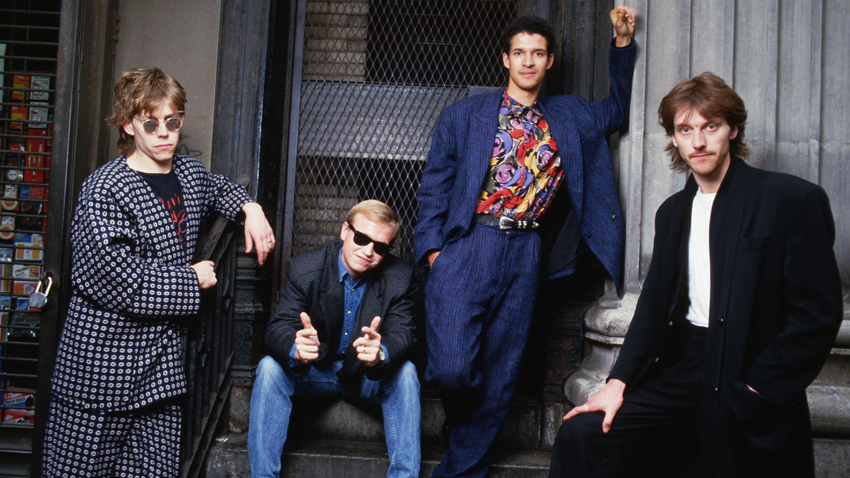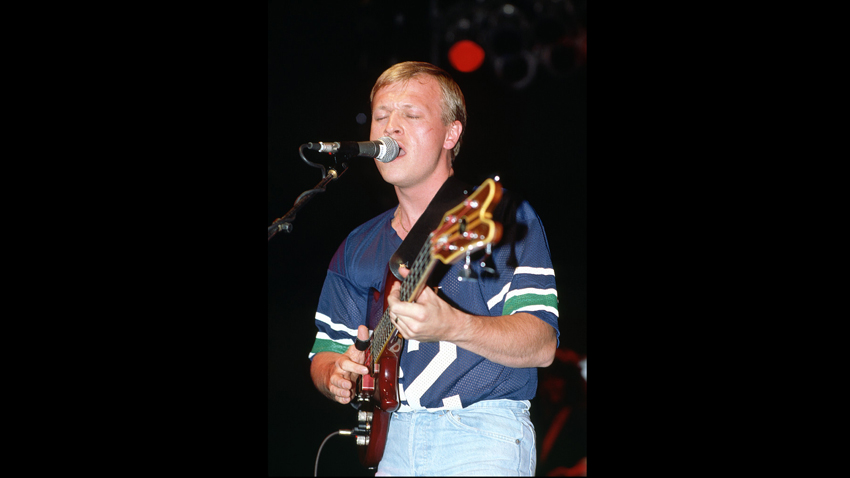
In the late '80s, Level 42 were one of the biggest British bands around, with a string of hits, arena tours and a sound that was driven by bassist and vocalist Mark King's distinctive slap bass technique. With the band back on the road, we caught up with King to talk synths, songwriting and strings...
It's now 26 years since breakthrough album Running In The Family - does it feel like it all happened that long ago?
Man and boy, I tell you it does, it feels like about 50 years. I think I've been dragging this album round forever, and I love doing it too, I have to say. It's an album that's been really good to us. When we laid it down in 1987, I don't think we realised that is was going to be as successful as it was. We were trying hard to make it as successful, because we were looking to pick up a new contract with Polydor Records. Plus, World Machine had done really well for us in '85, and that really kicked the door open for us in the States.

Level 42 in 1986. Credit: Lynn Goldsmith / Corbis
So there was a lot riding on the whole Running In The Family project, beginning of course with the single Lessons In Love. It was almost orphaned, because we were working very hard out in America, and Polydor needed something to be running with, because they couldn't take anything else from the world Machine album. We had this very small window just after Christmas in '87 to come up with something.
We convened round at my loft in Streatham, where I had an old 8-track studio, a reel-to-reel thing. It was lovely. Great days they were, in terms of gear, because of the limitations. It's not like today where you call Logic up and you've got limitless tracks on a terabyte drive that costs about thruppence. Back then, you had to try and jam stuff in, and I think in a lot of ways that was pretty good, because it did kind of polarise your thoughts and what you had to do to try and get an idea across in as few tracks as possible.
I'm sure the likes of The Beatles, who never had the luxury of 8 track, had the same feeling about it. Because when you've got loads of tracks, the temptation to stick peripheral musical nonsense on is really irresistible. Particularly if you're a musician, and a creative type, part of your remit when you're trying to come up with stuff is to be inventive, and of course it just goes nuts sometimes.
Want all the hottest music and gear news, reviews, deals, features and more, direct to your inbox? Sign up here.
So it was Lessons In Love that led into the rest of the recording for Running In The Family?
It was. We had this very small window to get stuff done in, because we were going straight back out to the States again. We came up with Lessons In Love, which was really an idea taken from a live version of A Physical Presence, which was the track we were touring at the time, and the way we were trying to end that.
We used to just fade songs, which gives you that conundrum when you take it out live, how do you end it? We'd always had a bit of a habit of making these big pompous endings, and this one was no different!
The idea was kind of taken from We'll Meet Again, that vibe. I dragged out the riff, which in essence was the whole melody, and said, "Look guys, I've got this, but with much more of a sixteenths feel with the machine gun bass going on behind it," which was kind of our trade mark.
Mike Lindup came up with that great middle eight, and Boon [Rowland Gould] had this killer lyric on it, the imagery was cracking. We did that and Children Say, which was also a single off the album, and a third track, Freedom Some Day. When you listen to those three in isolation, which was how we recorded them, they're three totally different tracks to each other, vibe wise, tempo wise.
We thought the best thing to do was to give the record company three alternatives different from each other, and see what they ran with. Having said that, history has proven that they're not always right about what they choose anyway. Very often as the artist it's much better delivering the fait accompli, because if you give them a choice they'll probably choose the wrong thing!

Mark giving his slapping thumb some abuse. Credit: Corbis
Was the writing process always as collaborative as that?
Yeah, largely it's been that way. The whole writing thing for me, apart from a couple of instrumental ideas I'd had as a teen, always began as Level 42. My first tuned instruments were played in Level 42, so I was either picking up the bass or a guitar, and strumming around on that. My keyboard playing leaves a lot to be desired, but it didn't matter when you had guys like Mike Lindup or Wally Badarou to be able to call up, because they're such masters of it anyway.
The whole collaborative thing was just how we always did it. It never used to be quite so full on, I think Lesson In Love is myself, Wally Badarou, Boon Gould and Mike Lindup, I think Phil [Gould] wasn't in on that one. It wasn't always that. More often that not, we'd pair up and I'd do something with Boon, or with Phil, or with Mike. Because that way, it kind of clears the decks of too much input.
I think by the very dint of being a musician, you have this slightly competitive edge, you want to get your ideas out. It's kind of a blessing and a curse all at the same time. You get loads of ideas come flying in, but you feel yourself having to try and make room for them, even if perhaps it's not the best thing in hindsight. But you don't know that until you go looking back further down the line.
I've been looking at the Running In The Family project under a microscope. I've just recently done an acoustic version of the whole thing, and that was very interesting.
What made you want to revisit them acoustically? Did you find yourself making a lot of changes?
On the last tour we did in 2010, a lot of the radio stations we visited for promo asked us to drop in with a guitar and sing one of the songs, which wasn't ideal as a slap bass player! So I got myself a nice Taylor guitar, and starting boning up on some of these things, and I really loved it. It's such a departure.
Of course, a lot of the Level 42 stuff, particularly the bigger hits, were so synth and sequence based that trying to approach these songs with an acoustic guitar pulls the lid right off of it. I had to forget the way it went, and concentrate on the really strong chorus melody or verse melody.
I'm really chuffed at the moment with a version of To Be With You Again that I did a couple of months back. It was released as a single and it did well for us, but it was very dance oriented. We were still keeping up the momentum of competing as a band that would be played in the clubs, which we were. The DJ's would remix it and stuff, and it was a very dance oriented thing. But when I looked at the lyrics Boon had come up with - and bearing in mind this was about three or four months before he left the band - I saw that they're really heartfelt.
I didn't realise that the guy was in such turmoil and such conflict with the career he'd had for the last seven years, and the fact that we were always working and his personal relationships were bombing because we were always on the road. That had never occurred to me at the time.
So to actually sit down with an acoustic guitar and re-work the thing was great, a real pleasure, and a treat to do. I sent it to Boon to have a listen, and he said "I absolutely love it, and that's what I meant!" So it's great, 25 years later, to put the record straight on it.
How was the recording process with Running In The Family? Did it all go smoothly?
It was done in two stages; we laid down three of the tracks just after Christmas '87 at Maison Rouge studios. These were SSL based studios - our engineer Julian Mendelsohn knew his way around the SSL stuff really well, and we liked the sound that was coming out of the desk itself. We were working 48 track analogue machines of course. Digital was on the horizon, and there were whispers about this Sony machine that had 32 tracks but it was very notchy, so we didn't want to go there. I think that Running In The Family was the first album we had that went straight to CD. Everything else before that was vinyl, so digital technology was in its infancy.
Did the knowledge that the album would be released on to CD play into decisions you were making in the studio, or were you approaching things the same way you had previously?
We were doing it the same way, we were looking at coming up with 40, 45 minutes of music top whack really. It used to be the physical limitations of vinyl - 22 minutes a side max, otherwise you had to go down to a much smaller groove which made the album much quieter and more prone to jumping - that shaped why we listened to the length of music we did. I'm still pretty much convinced that 40 minutes for a project is enough. When people start filling CDs up just to fill the space, I find that negative as opposed to positive creatively.
When Running In The Family came out, it was a huge commercial success - were you expecting it?
The World Machine album really did a great deal for us because it gave us our first top ten in America, so that was a bit of a result. The fact that it was giving us number ones in 17 countries, that was a bit of a surprise. It was a quantum leap between selling 60,000 albums and then suddenly shifting 600,000. Polydor then had this great whiz of an idea of three months into the album being out, re-releasing it and calling it a Platinum Edition. Bearing in mind it had already done really well and been up in the top 5, the Platinum Edition sold 600,000 copies in the first week in the UK. The record companies were already beginning to flex their remarketing muscles, which they've now gone absolutely nuts on.

Mark with one of his Status Graphite KingBasses - note the 'bend well'. Credit: Supri/X00477/Reuters/Corbis
When you went to tour the album, you were obviously playing to pretty significant crowds. How did that affect the band and your live performances?
Because of the World Machine thing, we were already starting to play Wembley Arena, so we just carried on. We were booked into more arena shows, and we were doing the NEC and the GMEX.
How about on the technical side of things - your rig must have exploded when you started playing arenas?
Bass-wise when we went to the States I had the huge compliment of Alembic coming up and saying they'd like to do a signature model. They thought I was using Alembic, it just so happened I was using Jaydee, it was just a very Alembic shape. This dude showed up one day with this little suitcase of matched book hardwoods, and asked me to choose some so they could make a couple of basses, which was absolutely brilliant. They the likes of Boogie and every amp manufacturer under the sun wanted to get involved, but I was pretty much stuck with using the Trace gear because I really liked it.
I first started using Trace Elliot from 1981. Back then it was about as high end and high fidelity as you could get. It started with the GP11, I've still got one of those, and then it went on to the GP12. It started to get a little bit overcomplicated, and they were putting compressors in. I can't stand compression on the bass when I'm playing live, I just find it's way too polite. I do like the whole transient thing of slapping the bass and popping, and it just being the strings and me doing it, and not some box reacting and clipping it.
Now I use TC Electronic stuff. It's great gear - I use the Blacksmith head which is a 1500 watt power unit, and it's got so much thump with a couple of 4x10s plus a couple of 2x10s. It's great, 'cos you can split the rig up and take it smaller if you want to go and do a TV show, and it all has the TC Electronic clarity.
This of course is all being front-ended by my Status Graphite basses, the KingBasses, they've just this year come out with the parametric one, it's called the KingBass Paramatrix. This thing does anything, it's got four pickups for a start, and you can select any combination. As a bit of knob twiddler anyway, I just like having all these things - invariably I'll end up turning everything up on full anyway!
What are the key requirements you look for in a bass?
I like really fast action, and I use very light strings - 30, 50, 70 and 90, all Rotosound. They're great for me, they're nice and bright and they're double ball end of course, because the Status is still a headless bass. At the zero nut, we've added about three inches of graphite and given it what we call the 'bend well'. The thing I missed about the headed bass was that you could bend harmonics, and you couldn't do that on the headless basses, so we sorted that out. Plus, the consistency of it - I use two basses on stage of a night as the strings start going off, because they take a hell of a pounding. So I'll swap basses half way through, and it's great to pick up a second bass and it be so like the bass you've just been playing, and feel so comfortable and consistent.
What about your pedalboard?
I'm TC'd up with pedals! I use quite a small board, I like to take it with me when I go abroad. I use a TC Electronic Flashback pedal, and I love it for the looping. I use the Hall Of Fame pedal, the reverbs on them are fantastic. I use a Vortex flanger, I've got a tone print on that called the Sweet Minger! And then there's the Corona pedal, which is pretty much a chorus, and the Dark Matter as well, because it's such a great overdrive pedal. The only non-TC stuff I've got is an MXR Autocue, which is an autowah pedal, and an MXR Bass Octave Deluxe unit. And that's my whole pedalboard, which is pretty full on really!
You were using Ashdown amps for a while weren't you?
I was, and they very kindly did a signature head for me, we worked together on that. About '97, '98, I did a solo project called One Man, and I wanted it to be different from Level 42 so I made a radical departure. Fender got in touch and knocked up a few Jazz Deluxe basses for me, and I really liked the sound. Mark Gooday called me up, he was just about to start Ashdown, and he had lovely gear that was really nice and warm.
I started touring with that, but the more touring I started doing and the more Level 42 material I started putting back in the set, the original Ashdown rig wasn't really cutting in with what was required for the slap side of things. They had big speakers, and really 10 inches is as big as you want to get when you're thumping very fast.
I've worked with Mark for such a long time from the Trace days, so I asked him to come up with something like the very first Trace rig I had. Then I asked him to make me something like a Trace GP12 but without all the compressors and things, and that's when they came up with the MK500 head which was absolutely great.
Then time passed again, and I was in Scandinavia and the TC Electronic guys came along because I'd had this love affair with their pedals. I thought it'd be a good move to make. Ashdown are off and running, but it was very nice to be there right at the beginning, as indeed I was with the Trace Elliot stuff.
To keep up to date with Mark King, visit the official Level 42 website.